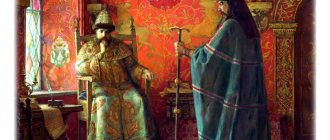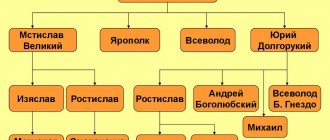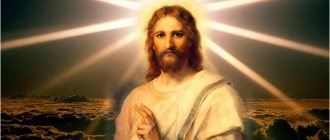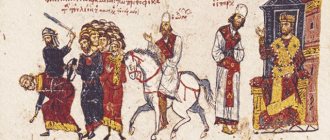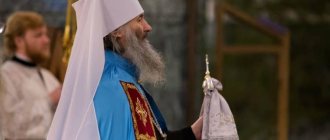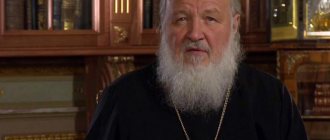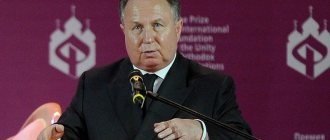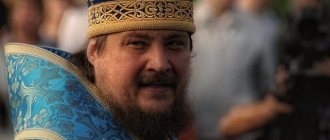"Zealot of Piety"
The future Patriarch was born in 1605 into the family of a Mordovian peasant Mina in the village of Veldemanovo, Nizhny Novgorod province. At baptism he received the name Nikita. In early childhood, he suffered a fair amount from his evil stepmother, and at the age of 12 he ran away from home to the Makaryevsky Zheltovodsk Monastery. Nikita turned out to be a fellow countryman of Avvakum, with whom he was even friends in his youth and who later became his main ideological opponent.
After spending several years as a novice in a monastery, Nikita did not take monastic vows because his dying father asked him to return home. Nikita got married and took care of the household. At the age of 20 he was ordained a priest. The competent and strict young priest caught the eye of the Moscow merchants, and Nikita was summoned to the capital, where he became the rector of one of the Moscow churches.
During ten years of marriage, priest Nikita’s three children died one after another. They say that it was in this that he saw a sign of God and finally decided to become a monk. He also convinced his wife to take monastic vows. For his monastic feat, Nikita chose the most severe of all Russian monasteries - Solovetsky. There, at the age of thirty, he took monasticism under the name Nikon and labored in the Holy Trinity Anzersk skete of the monastery.
With his indefatigable zeal, the initial elder of the monastery, Eleazar, liked him, and he appointed Nikon to manage the economic part of the monastery. There is a legend according to which it was Eleazar who predicted to Nikon that he would become Patriarch, since the elder had a vision of Nikon with an omophorion on his shoulders. In the Old Believer tradition, however, in the vision Nikon was not with an omophorion, but with a black serpent. Soon Nikon's irrepressible zeal became the cause of the conflict. He accused the brethren and Eleazar himself of love of money and fled from the Anzersky monastery. Nikon was accepted as a monk into the Kozheozersky monastery, and after some time the brethren elected him as their abbot.
In 1646 he came to Moscow to collect alms. According to the custom of that time, Nikon came to bow to Tsar Alexei Mikhailovich. His lively mind, education, and piety made such an impression on the 16-year-old sovereign that he left him in Moscow, appointing him archimandrite of the Novo-Spassky Monastery. Nikon became a mentor to the young tsar and entered an informal community of spiritual and secular people, which in Russian historiography is called the circle of “zealots of piety.”
These people set their task to revive church life in the country and general correction of morals. Nikon came to the king every week, talked with him on spiritual topics, discussed state affairs and brought requests from ordinary people who complained about “untruths.” Alexey Mikhailovich was very impressed by all this.
Patriarch
In 1649, Nikon was elevated to the rank of Metropolitan of Novgorod and Velikolutsk. Here he showed himself to be a wise statesman and, by all accounts, superbly demonstrated his energy and intelligence during the riot that occurred in Novgorod in 1650. Nikon did everything to quell the rebellion in the bud without excessive cruelty.
Patriarch Joseph died in 1652. The Emperor wanted to see Nikon on the Patriarchal throne. He resolutely refused. And then an incredible scene happened. In the Assumption Cathedral, in front of a large crowd of people, Alexei Mikhailovich fell at the feet of the son of a Mordovian peasant and, shedding tears, begged him to accept the Patriarchal dignity. After everyone else prostrated themselves after the king, Nikon gave his consent. However, at the same time, he took an oath from the king and all those present that they would obey him in everything in matters of faith. The Tsar, the boyars and the people took such an oath. This is how the vision of the Anzer elder Eleazar came true.
Nikon founded several monasteries: the Iversky Monastery on Lake Valdai, the Onega Cross Monastery on Kiy Island and Nikon’s most famous brainchild - the New Jerusalem Monastery, which he conceived as nothing less than the center of the Orthodox world and a repetition of the Church of the Resurrection of the Lord in Jerusalem.
He returned to church life the custom of preaching from the pulpit, abolished polyphony (the simultaneous performance of several chants, differing in words and melody), which made church services completely incomprehensible to the flock, and began to “correct” church books.
The Patriarch who split Rus'. Dreams and teachings of the monk Nikon
360 years ago, on July 20, 1658, Patriarch Nikon of Moscow and All Rus', offended by the tsar, left the patriarchal throne. The once all-powerful ruler was destined to turn into a simple monk. The church schism it generated tormented Russia for a long time.
On this day, the Feast of the Placement of the Lord's Robe was celebrated in the Kremlin Assumption Cathedral. This relic, kept in the Georgian Svetitskhoveli Cathedral in Mtskheti, was sent by the Persian Shah Abbas, having conquered Georgia, as a gift to Tsar Mikhail Fedorovich. Matins was served by Patriarch Nikon. Tsar Alexei Mikhailovich, contrary to tradition, did not come to the temple. This was the second consecutive case of the monarch’s absence from the patriarchal service: two days earlier he did not deign to attend the feast of the Kazan Mother of God.
After Matins, the Tsar sent Prince Yuri Romodanovsky in his place, who announced to Nikon: “The Royal Majesty is angry with you and for this reason I did not come to Matins and did not order you to wait for the holy litorgy.” To this the messenger added that the patriarch disdains the royal greatness: “You are called a great sovereign, but we have only one great sovereign—the king.” Nikon replied that Alexei Mikhailovich himself ordered him to be called this way. To this Romodanovsky responded: the sovereign honored him as a father and shepherd, but the patriarch did not appreciate the royal mercy, and therefore “from now on you will not be written or called a great sovereign, and you will not be honored in the future.”
This was a cruel blow for Nikon.
Patriarch Nikon with the brethren of the Resurrection New Jerusalem Monastery. Unknown artist. 1660–1665
Having ascended the throne at the age of 16, the young pious king soon found in Nikon, at that time the abbot of the Kozheozersk monastery, an older friend and mentor. Nikon became the archimandrite of the Moscow Novospassky Monastery, then the Metropolitan of Novgorod. In Novgorod, during the days of the uprising, he had a vision in the temple, which he described in a letter to the king:
And then suddenly I saw a royal golden crown in the air above the head of the Savior; and little by little this crown began to approach me; Out of great fear, I seemed to have lost my senses, I looked at the crown with my eyes and saw the candle in front of the Savior’s image burning, and the crown came and became a sinner on my head, I felt it on my head with both hands, and suddenly the crown became invisible.
It was Nikon who inspired the tsar with the idea of transferring the relics of St. Philip, the Metropolitan of Moscow and All Rus', from Solovki to Moscow, who dared to challenge Ivan the Terrible, was deprived of his dignity for this and strangled by Malyuta Skuratov. Nikon personally went to collect the relics. The relic was supposed to become a stern reminder of the rightness and fearlessness of spiritual power in front of secular power. Over Philip's coffin, the royal message delivered by Nikon to him was read. Alexey Mikhailovich prayed to the deceased to “resolve the sin” of Tsar Ivan, “inflicted on you by the unreasonable envy and incontinence of rage.”
By the time Nikon returned in July 1652, Patriarch Joseph died. A council convened on this occasion elected Nikon as patriarch, but he stubbornly refused such an honor. Finally, Alexei Mikhailovich publicly and tearfully asked Nikon to take the empty throne.
In the Assumption Cathedral, with the relics of St. Philippa, the king, lying on the ground and shedding tears with everyone around him, begged Nikon not to renounce. Nikon, turning to the boyars and the people, asked: “Will they honor him as an archpastor and father, and will they allow him to build a church?” Everyone swore that they would and would give, and Nikon agreed.
This is how Sergei Soloviev describes the scene.
Alexander Litovchenko. Tsar Alexei Mikhailovich and Nikon, Archbishop of Novgorod, at the tomb of the wonderworker Philip, Metropolitan of Moscow. 1886
The crown that Nikon dreamed of united the power of God and Caesar. If the young king dreamed of organizing his kingdom according to spiritual laws, then the patriarch thirsted for earthly glory and power. The concept of “Moscow - the Third Rome,” conceived by the monk Philotheus back in the 15th century (“two Romes have fallen, but the third stands, but there will never be a fourth”), it seemed, was close to being realized. All major Orthodox patriarchates in the East were under the rule of the Turkish Sultan. And only Rus' maintained independence, only the Russian church was in symphony, that is, harmony with the autocratic power of the monarch. Nikon is already equal to the autocrat: the tsar awarded him the title “great sovereign” and leaves him in the kingdom for the duration of his absences from Moscow. But if the Patriarch of Moscow becomes ecumenical, his authority will increase immensely.
The Eastern Patriarchates have already placed themselves in a position dependent on Moscow. Their hierarchs continually came to Moscow for “alms,” that is, for money for the maintenance of their churches and their own comfortable existence, lived there for years, receiving a generous royal salary and complaining about the heavy Turkish yoke, or even moved “for eternal life.” "
Russian church historian Nikolai Kapterev writes:
The motives that forced various eastern hierarchs to move to Russia were usually that they had a bad life at home, had to ... look for shelter somewhere else, and sometimes simply flee from court or creditors. They looked at Russia as a country where a clever, experienced and resourceful foreigner, taking advantage of his cultural superiority, skillfully playing the role of a sufferer persecuted by the Hagarians, can successfully occupy a prominent influential position, quickly make a fortune for himself and, with the help of the Moscow court, correct his shaky position in the east.
Nevertheless, it was not easy for the Russian shepherd to subjugate foreign autocephalies. To do this, it was necessary, first of all, to unify the ritual, and therefore to achieve uniformity in the liturgical books. “Book on the right” began before Nikon. People from the inner circle of Alexei Mikhailovich - boyar Fyodor Rtishchev, the tsar's confessor Stefan Vonifatiev, rector of the Kazan Cathedral Ivan Neronov, archpriests Avvakum and Loggin - formed a circle of “zealots of piety”, whose goal was to breathe life into the ossified body of the Russian church. Over the centuries, many errors and clerical errors have accumulated in handwritten books, preventing the comprehension of the true faith; illiterate priests did not understand the meaning of the sacred texts. Disorder reigned in the service: in order to save time, the priests read and sang different things simultaneously in several voices.
Nikon put the matter on a systematic basis. He ordered the books to be edited according to Greek models - after all, it was from the Byzantine Greeks that Rus' adopted its faith. There was no shortage of Greek theologians and translators in Moscow. Unanimity and preaching by the shepherd were introduced in church services. There were many innovations in the words of prayers recited from childhood, in the number and type of bows (earthly bows were replaced by bows). But the most radical solution was the replacement of the original Russian two-fingered sign of the cross with the Greek three-fingered one.
The patriarch's Hellenophilia knew no bounds. He began to wear a Greek hood, took up arms against the icons of the newfangled “Frankish letter” (that is, “Latin”) and demanded a return to the Byzantine canon. Once he inflicted formal execution on the “wrong” icons, as the priest of the Antioch Patriarchate Pavel of Aleppo tells in his notes:
During the sermon, Nikon ordered icons, old and new, to be brought, which some of the Moscow icon painters began to paint based on examples of Frankish and Polish paintings... Nikon gouged out the eyes of these images, after which the archers, who performed the duties of the royal heralds, carried them around the city, shouting: “who from now on, if he paints icons according to this model, he will suffer an exemplary punishment.” Seeing how the patriarch dealt with the icons, they thought that he was sinning greatly, became embarrassed and worried, and considered him an opponent of the icons. At this time, a pestilence occurred and the sun darkened before sunset on August 2. They thought: “everything that happened to us is God’s anger against us for the patriarch’s desecration of the icons.”
The Hellenization of the liturgy was fundamentally contrary to the plan of the “zealots of piety” - they intended to bring the church service in accordance with the ancient Russian charter and saw in the corrections of the Greeks pleasing the patriarch and, ultimately, heresy: not having their own printing houses, the eastern patriarchates print their books in foreign lands, where Catholics and Protestants insert a “fierce potion” into them - and that is why they have been languishing for two centuries under the rule of infidels. Duality is clearly visible in both Russian and Greek old icons.
Nikon punished his opponents with frenzied cruelty. But he underestimated the strength of resistance. To suffer for faith was a feat in the eyes of the people, not a shame. Archpriest Avvakum, subjected to torture and exiled to Siberia, became the leader of the schism. In the end, the matured king began to be burdened by the tutelage and arbitrariness of the patriarch. He was extremely worried about the confusion of minds generated by the reform.
The final break occurred over a minor issue: the tsar's okolnichy beat the patriarchal boyar (he was of a princely family), and the tsar was busy receiving a foreign guest and did not want to immediately sort out the quarrel and punish the culprit. This was followed by the significant absence of Alexei Mikhailovich from two consecutive festive services in the Assumption Cathedral.
Series "Split". Scriptwriter: Mikhail Kuraev, director: Nikolai Dostal. Cinema, 2011. Nikon resigns as patriarch. Nikon – Valery Grishko, Tsar Alexei Mikhailovich – Dmitry Tikhonov
Some historians portray Nikon's further actions as an emotional reaction to the insult inflicted on him. It is true that the patriarch was quick-tempered, but in this case he acted deliberately, like a PR master. He sent in advance to buy a stick from the ranks and ordered a bundle with a simple monastic robe to be brought to the temple. He arranged the service itself with all possible pomp, appearing before the flock in the sakkos of Metropolitan Peter and with his staff in his hand. Over the sakkos he put on the omophorion of the Sixth Ecumenical Council (7th century). After serving the liturgy, he ordered that no one should be allowed out of the cathedral, so that everyone could hear his teaching. From this order a legend subsequently arose that the doors to the temple were closed by the people who did not want to let the shepherd leave the throne.
Witnesses present Nikon's teaching in different ways, but the key phrases in the testimony coincide almost word for word. Metropolitan Pitirim of Krutitsa conveys Nikon’s words as follows:
I was too lazy to teach you, and I was no longer able to do so, and for my laziness I became handsome; and you, seeing my lack of teaching towards you, became proud of me; and he said with an oath: from this time on I will not be your patriarch; Even if I even think of being a patriarch, I will be anathema.
“To become crusty” means to become covered with scabs. Having finished his teaching, Nikon put on a monastic robe and took a simple stick in his hand. In the history of the Russian Church there has never been a voluntary abdication of a patriarch. Metropolitan Pitirim hastened with the sensational news to the royal court. Nikon did not go anywhere, but sat down to wait until the king came to ask him not to leave the throne. Soon, boyar Alexei Nikitich Trubetskoy appeared in the cathedral and gave him the royal message: “I told Patriarch Nikon: why is he leaving the patriarchate without consulting the great sovereign, and from whose persecution, and who is persecuting him? and so that he does not leave the patriarchate and remains as before.”
Sergei Miloradovich. Patriarch Nikon's break with Tsar Alexei Mikhailovich
But Nikon decided to be capricious some more. He handed Trubetskoy his letter to Alexei Mikhailovich and ordered him to ask the tsar to give him a cell, that is, to assign him to a monastery. The new answer was drier than the previous one. “And the great sovereign suddenly sent me to the patriarch, and ordered him to give that letter to the patriarch, and ordered him to say that he should not leave the patriarchate and be as before; and there are many cells in the patriarch’s courtyard, whatever he wants, live in that one.”
There was nothing to do. Nikon got ready and set off with a large convoy to the Resurrection New Jerusalem Monastery, secretly hoping that the king would come to his senses and call him back. In some apologetic works, Nikon's monastic life is depicted almost as a martyrdom. In February 1660, Prince Trubetskoy and solicitor Larion Lopukhin, who visited the former patriarch, found him in a poor cell, wearing rags and chains. But it was all a sham. Nikon was not at all distinguished by asceticism and literally did not deny himself anything.
The Tsar left in his personal ownership the Resurrection, Iversky and Krestny monasteries with all the lands assigned to them and serfs with a total of more than six thousand souls.
In November 1666, after long delays, a council was convened in Moscow for the trial of Nikon with the participation of two Eastern patriarchs. Nikon was accused of leaving the throne without permission. By his action, Nikon, according to the hierarchs, inflicted a bitter offense on the Tsar. Subsequently, in his letters he called the monarch “a Latin wise man, a tormentor and an offender”, blasphemed the Eastern patriarchs, etc., etc. The case materials also contained accusations of treason - information about Nikon’s secret relations with Stepan Razin, allegedly confirmed Razin himself was under torture, but it was decided not to disturb this topic. Nikon was expelled from the priesthood, declared a simple monk and sent to the Ferapontov Belozersky Monastery.
Series "Split". The Great Moscow Cathedral announces the verdict on Nikon
But even there he did not languish in captivity, as some modern authors claim. The monks of the Ferapontov Monastery complained to the new Patriarch Joachim that Nikon with his servants and the bailiff and a detachment of archers assigned to him had completely ruined the brethren:
And they made all sorts of mansion crafts and fish gardens and ponds for him; and they plowed the arable lands and mowed and transported hay, and worked in his vegetable gardens... and they caught fish, sir, along the lakes and along the Sheksna River in the monastery lands and brought them alive to the fish gardens to him... And from the previous ones, sir, many money and grain expenses and food supplies, and due to lack of plowing, everything in the Ferapontov Monastery has now become empty... the peasants have become completely destitute of horses and are in great debts of grain and money.
He died in August 1681 during the reign of Fyodor Alekseevich and, at the insistence of the new tsar, was buried with patriarchal honors. The schism of the Russian Orthodox Church continues to this day. In April 1905, Nicholas II, by decree “On strengthening the principles of religious tolerance,” legalized schismatics and ordered them to be called Old Believers. And only in October 2000, the Russian Orthodox Church Abroad (ROCOR) asked the Old Believers for forgiveness for the cruelties inflicted on their co-religionists. The Russian Orthodox Church did not do this either.
Reformer and "Antichrist"
The church reform, which led to a schism, did not arise out of nowhere. Centuries of disunity, political upheavals and conquests led to the fact that by the 17th century the Rite of the Russian Orthodox Church began to seriously differ from the Greek. Since the Russian people adopted the faith from the Byzantine Empire, Nikon decided to bring the rituals in the Moscow state into line with the Greek ones.
Researchers speak, however, of the Patriarch’s more far-reaching plans. It was at that time that the thesis “Moscow is the Third Rome” was finally established, and Nikon saw the sovereign of Moscow as the new emperor, himself as the Ecumenical Patriarch, and Moscow as the center of Orthodoxy, which replaced Constantinople, desecrated by the Turks. Of course, to realize such a plan it was necessary to make the Russian church rite closer to the Greek one.
In addition to revising the liturgical books and correcting errors in them made by copyists, Nikon also encroaches on such things as the “special hallelujah,” the direction of the religious procession, the clothing of the priesthood, and, finally, the sign of the cross. For most Russian people, liturgical texts were something very distant and incomprehensible; only a few literate clergy were truly indignant against the editing. But to walk in a procession of the cross against the sun, although since ancient times they walked salting, but to exclaim “Hallelujah” three times, although they always did it twice, and, finally, to be baptized “with three fingers” - it was impossible to come to terms with this. In addition, Nikon dressed the priesthood in Greek-style robes.
Maybe if Nikon and supporters of reforms had been patient and started introducing innovations gradually, everything would have passed more or less peacefully. But Nikon just didn’t have enough patience. The local Moscow Council under his chairmanship in 1656 declared everyone who crosses themselves with two fingers to be heretics and anathema. This was enough for the deaf resistance to become active. A split began. And if the supporters of the old rite were called “heretics,” then they responded by calling Nikon “the Antichrist.”
Nikon's reforms
In the days when the question of a new primate of the Russian Church was being decided, no one yet suspected what a tragedy these reforms would turn out to be for the country and people. Equally, it was difficult to foresee that the new patriarch would not be content with the role of an obedient executor, pleasing to the king of church politics. And he intends to elevate the priesthood above the kingdom. Actually, the church reform itself, begun by Nikon in 1653 - 1655, was as follows:
- baptism not with two, but with three fingers;
- replacing prostrations with bows;
- singing hallelujah three times instead of twice;
- the movements of believers in the church past the altar are not in line with the sun, but against it;
- the name of Christ began to be written differently - Jesus, instead of Jesus;
- all books and icons written according to old, non-Greek models were subject to destruction.
For believers, all these deviations were a significant violation of the traditional church canon, but a prayer pronounced not according to the canon, according to believers, is not only incorrect, it is blasphemous. Therefore, Nikon is immediately accused of Latinism. The fact is that the Greek Church tainted itself with the Union of Florence, concluded in 1439.
Being a powerful, strong-willed, even fanatical man, Nikon received immense power over believers. In relation to the tsar, he laid claim to the role that Filaret had once performed under Mikhail Fedorovich. Nikon strongly emphasized the primacy of spiritual power over secular power.
Exile
At first, Nikon's influence on the king was enormous. It got to the point that the words “great sovereign” were added to his title. But in the end, Nikon’s enormous power and his jealous attitude towards any encroachment on his authority in church affairs led to a cooling of relations with the tsar. In 1658, the Patriarch and Alexei Mikhailovich finally quarreled, and Nikon, as a sign of protest, left Moscow and retired to the New Jerusalem Resurrection Monastery.
Perhaps he hoped that Alexey Mikhailovich, as of old, would kneel and beg for his mercy. However, things turned out differently. The Tsar decided to deprive Nikon of his bishopric, for which he assembled a court of Eastern Patriarchs. In 1666, the large Moscow Cathedral opened, at the final meeting of which Nikon's trial took place.
The court decided to expel Nikon from the priesthood, depriving him of not only the patriarchal rank, but also the episcopal rank. The list of Nikon’s crimes, for which he was so severely punished, is very indicative, since it gives a clear idea of the character of this extraordinary man. Thus, Nikon was expelled from the priesthood, in particular, for the fact that “he anathematized the patriarchs Paisius and Macarius, calling them Anna and Caiaphas, and called the royal ambassadors who were sent to him to summon him to trial Pilate and Herod,” “without any conciliar consideration he deprived Bishop Paul of Kolomna of his rank, having himself pulled off Paul’s mantle,” “he mercilessly beat his spiritual father for two years and inflicted ulcers on him,” and so on. Of course, among other sins it was pointed out that Nikon did not humble himself before the king, but continued to persist in his offense.
Nikon was sent to the Kirillo-Belozersky Monastery, where he lived as a simple monk until 1681. After the death of Alexei Mikhailovich, his son Fyodor Alekseevich allowed Nikon to return to Moscow. However, on the way, Nikon, who was already ill by that time, died. Fyodor Alekseevich insisted on Nikon's funeral service as Patriarch. Subsequently, he ensured that the Eastern Patriarchs returned Nikon's dignity.
